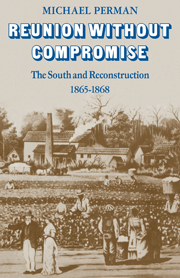Book contents
- Frontmatter
- Contents
- Preface
- Part I Conciliation and conflict
- Part 2 Encouraging Southern loyalty, 1865
- 2 The Provisional Governors
- 3 Strategies for readmission
- 4 Discretion decentralized
- 5 Misrepresentation
- Part 3 Seeking Southern cooperation, 1866
- Part 4 Demanding Southern acquiescence, 1867–1868
- Epilogue: The irrelevance of the moderates, 1865–1868
- Appendix: Registration and voting statistics for the Southern State Constitutional Conventions, 1867–8
- A note on sources
- Index
3 - Strategies for readmission
Published online by Cambridge University Press: 05 August 2012
- Frontmatter
- Contents
- Preface
- Part I Conciliation and conflict
- Part 2 Encouraging Southern loyalty, 1865
- 2 The Provisional Governors
- 3 Strategies for readmission
- 4 Discretion decentralized
- 5 Misrepresentation
- Part 3 Seeking Southern cooperation, 1866
- Part 4 Demanding Southern acquiescence, 1867–1868
- Epilogue: The irrelevance of the moderates, 1865–1868
- Appendix: Registration and voting statistics for the Southern State Constitutional Conventions, 1867–8
- A note on sources
- Index
Summary
The President's intended plan
Early in September, 1865, William H. Seward, the Secretary of State, received a communication from a Georgia Whig, Wylly Woodbridge. Woodbridge had a suggestion to offer regarding Federal restoration policy. ‘You once resided in our State,’ he wrote, ‘and have a mastery over Constitutions – the present is to ask you to have one prepared for us to be submitted to the Convention; if you will send it to me its origin will be a mystery it shall be copied by my own hand, and placed into proper management.’ Seward, in reply, thanked the Georgian for his suggestion and concluded, ‘It is best however that the proceedings of the State convention should not only appear to be but really be spontaneous. Governor Brown and others from Georgia have been with us here and I am sure that they go away well informed of our views about what is necessary to restore the proper and natural relations between the States lately in armed rebellion and the loyal States, and the people of both.’
Of course, the Southern States could have been prepared for readmission by subterfuges such as Woodbridge suggested. Similarly, though less covertly, the terms for readmission could have been dictated to the defeated Southern enemy. These possibilities, however, were rejected by the Administration in 1865 as later they were also to be by Congress when it presented its own plans during 1866 and 1867.
- Type
- Chapter
- Information
- Reunion Without CompromiseThe South and Reconstruction: 1865–1868, pp. 68 - 109Publisher: Cambridge University PressPrint publication year: 1973



